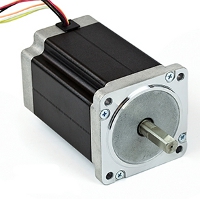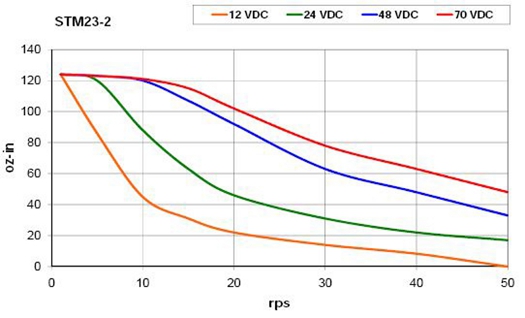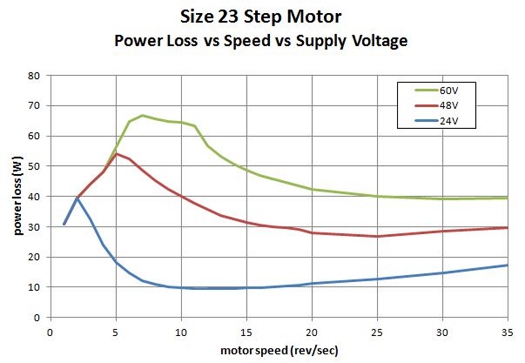 |
| May 07, 2019 | Volume 15 Issue 17 |
Designfax weekly eMagazine
Archives
Partners
Manufacturing Center
Product Spotlight
Modern Applications News
Metalworking Ideas For
Today's Job Shops
Tooling and Production
Strategies for large
metalworking plants
Three causes of step motor heating and how to avoid them
By Eric Rice, National Marketing Director, Applied Motion Products
 Step motors convert electrical power into mechanical power to accurately rotate and position a load. Because step motors are not perfectly efficient, some of the electrical power turns into heat on its way through the motor. This heating is not so much dependent on the driven load but on motor speed and power supply voltage.
Step motors convert electrical power into mechanical power to accurately rotate and position a load. Because step motors are not perfectly efficient, some of the electrical power turns into heat on its way through the motor. This heating is not so much dependent on the driven load but on motor speed and power supply voltage.
Operators may want to run motors at higher voltages to achieve more torque and higher speeds. As shown in Chart 1, a motor operating at 70 VDC (red curve) achieves much higher speed and torque than operating at 12 V (orange curve). So why not always use 70 V or, better yet, apply 100 V and really flatten the curve? And why stop there? Since torque is directly proportional to current, why not increase the current setting to get more torque at low speeds, too?

Chart 1: The greater voltages applied to a motor create higher torques. But heat can be a problem at higher voltages.
The problem is heat
When operating at high voltages and currents, step motors get warm or even hot. That's okay if the motor surface temperature doesn't exceed 100 C and the internal temperature remains cool enough to prevent melting of the winding insulation. The insulation of the magnet wire inside the motor is most susceptible to heat. Most step motors utilize Class B insulation, so the internal temperature of the motor is limited to 130 C. If the insulation melts, the windings will short and the motor will no longer operate properly.
So, what are the sources of heating in a step motor? There are three primary sources:
- Coil resistance
- Hysteresis
- Eddy currents
1.Coil resistance
Magnet wire that comprises the coils of a motor winding has resistance. Current is passed through the coils to generate torque. Generated as a byproduct, heat is proportional to the resistance of the coils times the square of the applied current. Getting twice as much torque from a motor requires doubling the current, which in turn makes the motor four times as hot. For this reason, operators should follow the rated current specification for a step motor to avoid overheating.
2. Hysteresis
When spinning, the rotor causes the magnetic field in the stator steel to reverse each time the rotor and stator teeth pass each other. This changing field heats the stator steel and is called hysteresis loss. Hysteresis loss occurs even when the motor does not produce output power. For example, disconnecting a step motor from the drive and spinning the shaft will still create heat due to hysteresis. And the faster the motor spins, the greater the hysteresis loss, regardless of applied current or voltage.
3. Eddy currents
For a motor to produce output power, alternating current must drive the stator coils. The current causes an alternating magnetic field in the stator steel, which, in turn, induces an electric current in the steel itself, called an eddy current, as described by Ampere's Law.

Chart 2 below illustrates how the sum of all three sources of heat is affected by speed and voltage. By increasing the voltage and the current setting, the motor has a greater chance of overheating and failing.

Chart 2: The greater voltages applied to a motor create greater losses. Running step motors at rated current and with appropriate supply voltages avoids overheating.
Avoid motor overheating
A properly sized motor for the load that is operating at a safe current setting and supplied with an appropriate power supply voltage can avoid the occurrence of overheating and failure. Below are three additional tips to avoid motor overheating.
1. Reduce holding current
Step motors typically reach maximum temperature after 30 to 45 minutes of operation. A motor running for one minute and idling for one minute is at 50 percent duty cycle. Five minutes on and five minutes off is also 50 percent duty. However, a motor operating one hour on and one hour off is effectively running at 100 percent duty because it will reach full (and possibly excessive) temperature during the first hour. Avoid running the motor at full duty cycle over time.
In addition, reduce current when a motor idles because holding the load typically requires less torque than accelerating the load or turning it at velocity. Most modern stepper drives are capable of automatically adjusting idle/holding current to any value between 0 and 100 percent of running current. If a step motor sits idle for even a modest amount of time, reducing the idle current significantly reduces heat.
2. Reduce running current
Many companies specify oversized stepper motors that have more than enough torque for the application. If so, operators can reduce the motor's running current to reduce its temperature. To determine if this is possible, reduce the running current by small amounts until the motor mispositions or stalls. Then, increase the current until accurate positioning resumes.
3. Switch to a closed-loop step motor system
A closed-loop step motor system uses encoder feedback to accurately control motor current, velocity, and position. When the motor isn't producing torque or is producing less than maximum torque, current to the motor is automatically reduced in proportion. This closed-loop control scheme significantly reduces motor temperature by as much as 50 percent in some applications.
To ensure motors operate properly without generating excessive heat, users should refer to the hardware manual for their manufacturer's stepper drive, which will provide detailed instructions for correctly choosing, installing, and operating a stepper motor according to specific application requirements.
Have questions? Contact the author at erice@applied-motion.com.
Learn more about Applied Motion Products here.
Published May 2019
Rate this article
View our terms of use and privacy policy
